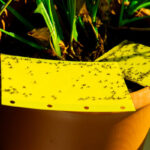For plant lovers, the sight of pests can be truly disheartening. It’s especially unpleasant when these unwanted guests decide to make our indoor plants their home, bringing the problem right into our living spaces. Often mistaken for fruit flies buzzing around your fruit bowl, the tiny flies you see around your houseplants are frequently fungus gnats. These small, winged insects, resembling miniature mosquitoes, are about the same size as fruit flies and can be a nuisance. Fortunately, these plant flies are generally less destructive than many other common plant pests, and even better news, getting rid of them is quite manageable.
Identifying the Culprits: Fruit Flies vs. Fungus Gnats
Before we dive into how to rid fruit flies from your plants, let’s clarify something important: you’re likely not dealing with actual fruit flies on your plants. Fruit flies are primarily attracted to overripe or fermenting fruits and vegetables. The small flies you see hovering around your potted plants are usually fungus gnats. While both are small and annoying, they have different habits and require slightly different approaches to eliminate.
Fungus gnats are easily recognized by their slender bodies, long legs, and clear wings. They are drawn to moist soil rich in organic matter, which makes your plant pots an ideal breeding ground. You’ll see them fluttering around the soil surface and plant containers, but unlike some pests, they don’t typically feed on the plant’s leaves. Instead, their larvae live in the soil, feeding on plant roots and decaying organic material. Despite not attacking foliage directly, a significant infestation of these plant flies can still cause considerable damage to your beloved plants.
Understanding the Fungus Gnat Life Cycle
Adult fungus gnats have a short lifespan of about a week, but don’t let that fool you. In that brief time, a single female can lay up to 300 eggs under favorable conditions. With a rapid life cycle of just 3-4 weeks from egg to adult, populations can explode quickly. This rapid reproduction rate underscores the importance of taking swift action as soon as you notice signs of a fungus gnat infestation.
Signs of a Fungus Gnat Infestation
Identifying a fungus gnat problem is usually straightforward. These plant flies aren’t strong fliers, preferring to stay close to their breeding ground – your plants. You’ll often see them flying in erratic, zig-zag patterns near the soil surface. Due to their fast breeding cycle, you might observe all stages of their life cycle simultaneously. If you gently disturb the topsoil, you’ll likely see the larvae wriggling within. Fungus gnat larvae have translucent bodies with shiny black heads and reside in the soil, where they feed on organic matter and plant roots.
As winter approaches and many bring their tender plants indoors, fungus gnat populations can peak. Dormant plants require less water, leading to soil that stays moist for longer periods. This consistently damp soil, which can also promote root rot and fungal growth, becomes a perfect breeding environment for gnats. Be vigilant when bringing outdoor plants inside for the winter, as you could unknowingly introduce these unwanted pests into your home.
If a fungus gnat infestation is left unchecked, your plants will start showing signs of stress. While adult gnats don’t directly damage leaves, the larvae feeding on root hairs and depleting essential soil nutrients will weaken your plants. This root damage can manifest as sudden wilting and yellowing leaves, stunted growth, and a general decline in plant health. Therefore, prevention and timely, natural control methods are crucial to avoid a full-blown infestation.
Effective Strategies to Rid Fruit Flies (Fungus Gnats) from Plants
Now that we’ve established that we’re tackling fungus gnats when discussing “fruit flies” on plants, let’s explore effective methods to get rid of these pests and prevent future infestations:
-
Let the Soil Dry Out: Fungus gnats thrive in consistently moist soil. Allowing the top inch or two of soil to dry out between waterings makes the environment less appealing for them to lay eggs and for larvae to survive. This is often the simplest and most effective first step.
-
Bottom Watering: Switch to bottom watering to keep the topsoil surface drier. Place your plant pot in a dish of water and allow it to absorb moisture from the bottom up. This encourages roots to grow deeper and keeps the surface less attractive to gnats.
-
Sticky Traps: Yellow sticky traps are highly effective at capturing adult fungus gnats. Place these traps near your plants, close to the soil surface. The adult gnats are attracted to the yellow color and get stuck, breaking the breeding cycle.
-
Beneficial Nematodes: Introduce beneficial nematodes to the soil. These microscopic worms are natural predators of fungus gnat larvae. They are a safe and effective biological control method that targets the larvae in the soil without harming your plants or you.
-
Bacillus thuringiensis israelensis (Bt): Bt is a naturally occurring bacterium that is toxic to fungus gnat larvae. You can find Bt products specifically formulated for fungus gnat control. Apply it as a soil drench according to product instructions.
-
Repot with Fresh Soil: In severe infestations, consider repotting your plant with fresh, sterile potting mix. This removes the infested soil and any larvae within it. Be sure to clean the pot thoroughly before repotting.
-
Improve Drainage: Ensure your pots have adequate drainage holes and avoid using overly dense potting mixes that retain too much moisture. Good drainage helps prevent consistently soggy soil conditions that fungus gnats love.
Conclusion: Proactive Plant Care is Key
Dealing with fungus gnats, often mistaken as fruit flies on plants, can be a common annoyance for houseplant enthusiasts. However, by understanding their life cycle, recognizing the signs of infestation, and implementing these effective strategies, you can successfully rid your plants of these pests. Remember, maintaining proper watering habits and ensuring good soil drainage are crucial preventative measures. With a bit of vigilance and proactive plant care, you can keep your indoor garden thriving and pest-free.
